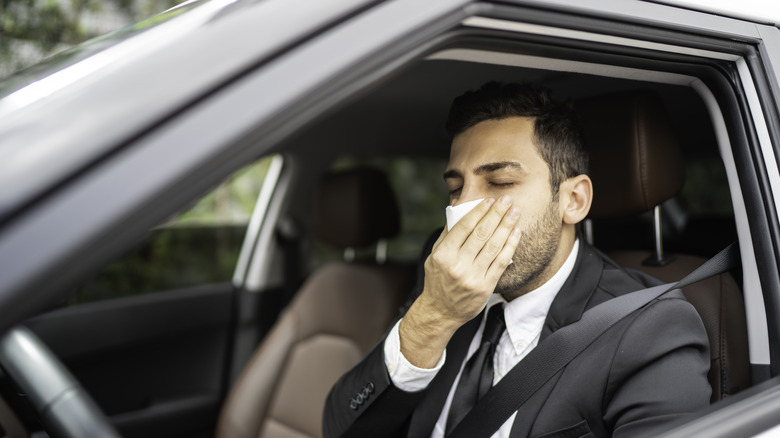Cars Could Be Giving Us Cancer: Here's What Researchers Suggest To Stay Safe
"Commuting to work shouldn't come with a cancer risk, and children shouldn't breathe in chemicals that can harm their brains on their way to school," says Dr. Lydia Jahl, a senior scientist at the Green Science Policy Institute. Co-author of a research paper that has been published in the Environmental Science & Technology journal, Jahl is talking about the presence in cars of flame-retardant chemicals that have been linked with cancer.
The peer-reviewed research paper focuses on flame retardants, which are added to seat foam in cars to comply with the NHTSA's Federal Motor Vehicle Safety Standard (FMVSS) 302 rule. The rule has remained unchanged since its introduction in 1971. In that spell, multiple scientific tests have linked the chemicals found in flame retardants with cancerous aftereffects from exposure, leading to a restriction mandate in states like California.
As part of the latest research, the team studied cars assembled after 2015 and analyzed them across summer and winter seasons to study the presence of flame-retardant chemicals in the cabin air, and also confirmed their origin. The team found tris(1-chloro-isopropyl) phosphate (TCIPP) — a compound that falls under the organophosphate esters (OPEs) class of fire retardants — in 99% of the vehicles they analyzed. It's worth noting that the U.S. National Toxicology Program has classified it as a potential carcinogen after finding evidence of cancerous growth in mice exposed to TCIPP.
The risk factors
In addition to analyzing cabin air, the team also collected foam samples from car seats and found it to be the source of these harmful chemicals. The investigation also uncovered the presence of other hazardous compounds like tris (1,3-dichloro-2-propyl) phosphate (TDCIPP) and tris (2-chloroethyl) phosphate (TCEP). The former was added to the California Proposition 65 (Prop 65) list in 2011, and has already been banned from making its way to products like mattresses.
The foam in car seats seems to release these chemicals into the air circulating in a car cabin, but it's not the only point of origin. Even if the foam in the seats didn't have this chemical, it was still detected in the silicone samplers inside the car — albeit at significantly lower levels. According to the research paper, other potential sources in the car could be elements like headrests, the ceiling fabric, and padding, all of which may contain foam treated with fire retardant chemicals.
One observation about chemical exposure was the correlation with temperature: the higher the temperature, the greater the diffusion of these harmful chemicals into the cabin air. The existence of TCIPP in foam resulted in air concentrations four times higher in winter and about nine times higher during summer, indicating that flame retardants used in vehicle interiors contribute to higher OPE exposure during warmer weather.
The road ahead
The research team suggests that by managing their vehicle's cabin temperature and parking in a garage or shaded area rather than under direct sunlight, car owners can lower the cabin temperature and decrease the level of flame retardants released into the air. But that's not an effective solution. "Auto manufacturers should try changing material designs to meet FMVSS 302 without flame-retardant chemicals, for example, by using tightly woven textiles that are adhered to the foam," Dr. Jahl tells SlashGear.
"Manufacturers can also look into design changes to find materials that are inherently more flame-retardant, and minimize the use of highly flammable polyurethane foam." But putting the onus on carmakers is not the ideal way forward, especially from a compliance perspective. The repeated failures of Tesla's advanced driver assistance system that have resulted in multiple casualties and multiple NHTSA investigations that have failed to conclusively solve the issue, are an apt example of the complex regulatory situation here.
The change has to come in the form of an industry-wide policy update. "We held meetings with NHTSA before the study was published, but they did not confirm to us whether or not they were going to look into updating the standard," Dr. Jahl tells us. After the report was published, the NHTSA assured Dr. Jahl that it is looking into it, but there is no certainty if, or when, the Federal Motor Vehicle Safety Standard (FMVSS) 302 norms will be updated.
What should an average car owner do?
"Ensuring plenty of ventilation through open windows and limited use of recirculated air mode are the easiest ways to reduce exposure," Dr. Jahl tells SlashGear. She further adds that keeping the car clean can be useful, especially for children, as accidentally swallowing dust can add to flame retardant exposure. Wearing a mask might also lower the exposure to particles in the car, but it won't help with the off-gassed flame retardants released into the air, notes the scientist.
"The only surefire way to drastically reduce exposure would be for flame retardants not to be added in the first place, which will require NHTSA to update its standard," Dr. Jahl adds on a concluding note. To bring more attention to the concerning findings and ask for a remedy, Consumer Reports has started a petition seeking public support, with the goal of attracting the NHTSA's attention. The aim is to push for an update to the flammability standard and reduce the exposure to toxic chemicals in cars. "These chemicals will only delay fires for seconds, and when they burn, the flame retardants create additional smoke, soot, toxic gases, dioxins, and furans, which are the main causes of fire deaths and contribute to firefighter cancer," notes the petition.



